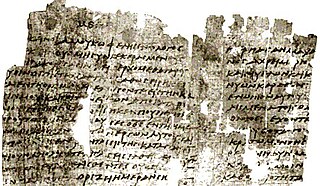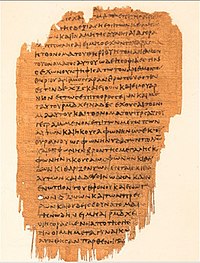
Matthew 23 is the twenty-third chapter in the Gospel of Matthew in the New Testament section of the Christian Bible, and consists almost entirely of the accusations of Jesus against the Pharisees. The chapter is also known as the Woes of the Pharisees or the "Seven Woes". In this chapter, Jesus accuses the Pharisees of hypocrisy. Some writers treat it as part of the final discourse of Matthew's gospel.

Revelation 12 is the twelfth chapter of the Book of Revelation or the Apocalypse of John in the New Testament of the Christian Bible. The book is traditionally attributed to John the Apostle, but the precise identity of the author remains a point of academic debate. This chapter contains the accounts about the woman, the dragon, and the child, followed by the war between Michael and the dragon, then the appearance of the monster from the sea. William Robertson Nicoll, a Scottish Free Church minister, suggests that in this chapter the writer has created a Christianised version of a Jewish source which "described the birth of the Messiah in terms borrowed from ... cosmological myths [such as] that of the conflict between the sun-god and the dragon of darkness and the deep".

2 Corinthians 11 is the eleventh chapter of the Second Epistle to the Corinthians in the New Testament of the Christian Bible. It is authored by Paul the Apostle and Timothy in Macedonia in 55–56 CE. According to theologian Heinrich August Wilhelm Meyer, chapters 10–13 "contain the third chief section of the Epistle, the apostle's polemic vindication of his apostolic dignity and efficiency, and then the conclusion".

2 Peter 3 is the third chapter of the Second Epistle of Peter in the New Testament of the Christian Bible. The author identifies himself as "Simon Peter, a bondservant and apostle of Jesus Christ" and the epistle is traditionally attributed to Peter the Apostle. Alternatively, it is considered a work of Peter's followers, written between 60 and 90 CE.

Revelation 3 is the third chapter of the Book of Revelation or the Apocalypse of John in the New Testament of the Christian Bible. The book is traditionally attributed to John the Apostle, but the precise identity of the author remains a point of academic debate. This chapter contains messages to the churches of Sardis and Philadelphia and Laodicea, three of the seven churches of Asia located in modern-day Turkey, continuing from the messages for the other four churches which appear in chapter 2.

Hebrews 1 is the first chapter of the Epistle to the Hebrews in the New Testament of the Christian Bible. The author is anonymous, although the internal reference to "our brother Timothy" causes a traditional attribution to Paul, but this attribution has been disputed since the second century and there is no decisive evidence for the authorship. This chapter contains the introduction ('exordium') about God's final revelation ('word') through his son and how the son is superior to angels.

Hebrews 7 is the seventh chapter of the Epistle to the Hebrews in the New Testament of the Christian Bible. The author is anonymous, although the internal reference to "our brother Timothy" causes a traditional attribution to Paul, but this attribution has been disputed since the second century and there is no decisive evidence for the authorship. This chapter contains the exposition about the superiority of Christ's Priesthood through Melchizedek to the Levitical Priesthood.

Hebrews 10 is the tenth chapter of the Epistle to the Hebrews in the New Testament of the Christian Bible. The author is anonymous, although the internal reference to "our brother Timothy" causes a traditional attribution to Paul, but this attribution has been disputed since the second century and there is no decisive evidence for the authorship. This chapter contains the exposition about Christ's effective sacrifice and the exhortation to continue in faithfulness and expectancy.

Revelation 4 is the fourth chapter of the Book of Revelation or the Apocalypse of John in the New Testament of the Christian Bible. The book is traditionally attributed to John the Apostle, but the precise identity of the author remains a point of academic debate. This chapter contains an inaugural vision of heaven, portraying the throne room of heaven, and the heavenly worship which the writer observes there.

Revelation 5 is the fifth chapter of the Book of Revelation or the Apocalypse of John in the New Testament of the Christian Bible. The book is traditionally attributed to John the Apostle, but the precise identity of the author remains a point of academic debate. This chapter contains the inaugural vision of the lamb on the throne in heaven.

Revelation 7 is the seventh chapter of the Book of Revelation or the Apocalypse of John in the New Testament of the Christian Bible. The book is traditionally attributed to John the Apostle, but the precise identity of the author remains a point of academic debate. Chapter 6 to Chapter 8:5 record the opening of the Seven Seals. This chapter contains the writer's vision of "the Four Angels of the Four Winds", the sealing of the 144,000 and the "Praise of the Great Multitude of the Redeemed". The passage in this chapter is 'an intercalation in the numbered series of seven'.

Revelation 8 is the eighth chapter of the Book of Revelation or the Apocalypse of John in the New Testament of the Christian Bible. The book is traditionally attributed to John the Apostle, but the precise identity of the author remains a point of academic debate.

Revelation 9 is the ninth chapter of the Book of Revelation or the Apocalypse of John in the New Testament of the Christian Bible. The book is traditionally attributed to John the Apostle, but the precise identity of the author remains a point of academic debate. In this chapter, the next two angels' trumpets are sounded, following the sounding of the first four trumpets in chapter 8. These two trumpets and the final trumpet, sounded in chapter 11, are sometimes called the "woe trumpets".

Revelation 11 is the eleventh chapter of the Book of Revelation or the Revelation of Jesus Christ shown to John in the New Testament of the Christian Bible. The book is traditionally attributed to John the Apostle, but the precise identity of the author remains a point of academic debate. This chapter contains the accounts related to the sounding of the "Seventh Trumpet".

Revelation 10 is the tenth chapter of the Book of Revelation or the Apocalypse of John in the New Testament of the Christian Bible. The book is traditionally attributed to John the Apostle, but the precise identity of the author remains a point of academic debate. This chapter and the first part of the next chapter report two episodes which intervene between the sounding of the sixth and seventh trumpets.

Revelation 14 is the fourteenth chapter of the Book of Revelation or the Apocalypse of John in the New Testament of the Christian Bible. The book is traditionally attributed to John the Apostle, but the precise identity of the author remains a point of academic debate. This chapter contains the accounts of the lamb with 144,000 followers, the three angelic messages and the voice from heaven, as well as the harvest of the earth and the vintage of the earth. The Three Angels' messages in verses 6 to 12 form a central feature of the teaching and mission of the Seventh-day Adventist Church: "“Make disciples of Jesus Christ who live as His loving witnesses and proclaim to all people the everlasting gospel of the Three Angels’ Messages in preparation for His soon return".

Revelation 16 is the sixteenth chapter of the Book of Revelation or the Apocalypse of John in the New Testament of the Christian Bible. The book is traditionally attributed to John the Apostle, but the precise identity of the author remains a point of academic debate. This chapter describes the seven bowls, vials or phials of God's wrath, poured out on the wicked and the followers of the Antichrist after the sounding of the seven trumpets, on the command of "a loud voice from the temple" heard by the author.

Revelation 17 is the seventeenth chapter of the Book of Revelation or the Apocalypse to John in the New Testament of the Christian Bible. The book is traditionally attributed to John the Apostle, but the precise identity of the author remains a point of academic debate. This chapter describes the judgment of the Whore of Babylon.

Revelation 18 is the eighteenth chapter of the Book of Revelation or the Apocalypse of John in the New Testament of the Christian Bible. The book is traditionally attributed to John the Apostle, but the precise identity of the author remains a point of academic debate. This chapter describes the fall of Babylon the Great.

Revelation 19 is the nineteenth chapter of the Book of Revelation or the Apocalypse of John in the New Testament of the Christian Bible. The book is traditionally attributed to John the Apostle, but the precise identity of the author remains a point of academic debate. In this chapter, heaven exults over the fall of Babylon the Great.













